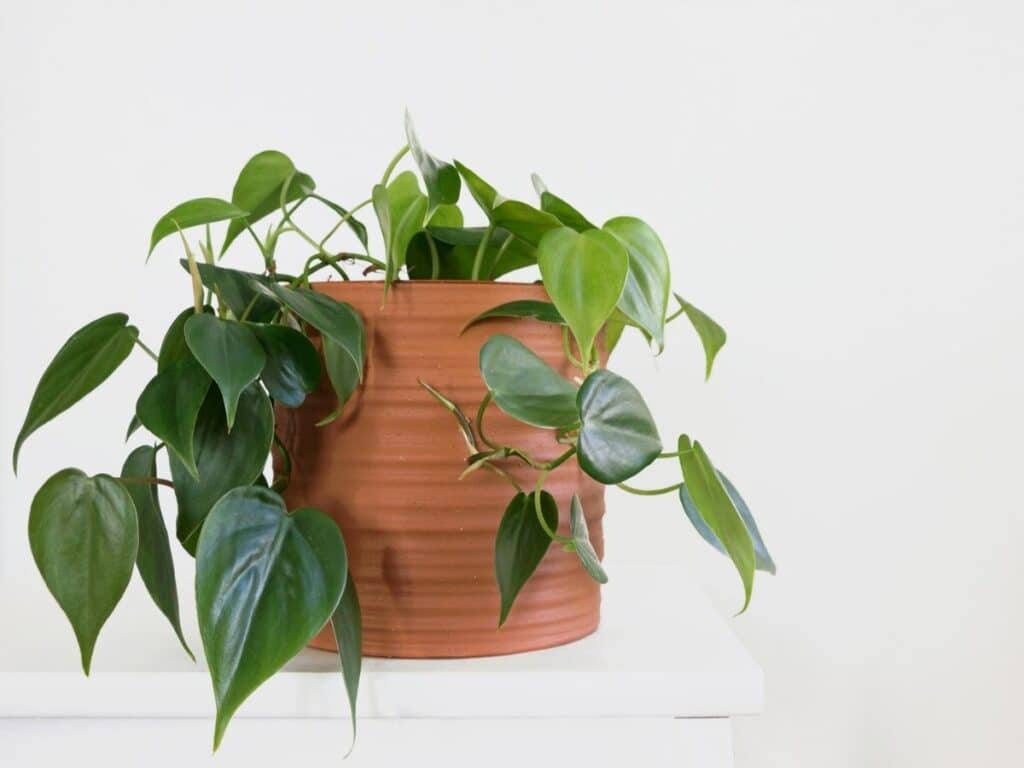Philodendron hederaceum or heartleaf Philodendron is one of the world’s favorite houseplants. These evergreens from the Araceae family look equally at home climbing a moss pole or trailing on a tabletop or from a hanging basket. What’s more, they are very forgiving and easy to grow, making them suitable for beginners and experts alike.
What is a Philodendron hederaceum?
Although this plant’s formally accepted name is Philodendron hederaceum, the species still goes by the synonyms P. micans and P. scandens in the horticultural trade. It is a widespread South American aroid from the Araceae family that grows as a hemiepiphyte in moist tropical forest environments. Its stems can grow to several feet in length, although they are easily managed indoors.
This plant species has been developed into many celebrated cultivars like the popular ‘Brazil’. While the wild form might not have the same flair as the more colorful cultivars, this plant still has a natural beauty and tropical look.
Does Philodendron hederaceum Bloom?
This is a true foliage plant in the sense that it rarely flowers and is grown for its form and foliage rather than its blossoms. Flowering is possible in mature specimens, however. The inflorescence is green to yellowish-white.
Is Philodendron hederaceum Toxic?
Unfortunately, this species is toxic to both people and pets. It is dangerous if eaten but will also cause irritation if it comes into contact with the eyes or sensitive skin. Take basic precautions when working with these trailing plants and be sure to keep them out of reach of pets and children.
How to Care for Heartleaf Philodendron
These heartleaf philodendron plants are relatively low-maintenance and easy to care for once you understand their basic needs. Providing the right moisture and light levels are the most important keys to success. Read on to learn more philodendron care tips, and other factors in more detail.
Sunlight
These tropical plants naturally occur in heavily vegetated areas where they receive dappled light or partial to full shade. They will grow best in bright but indirect light when grown indoors. Choose an area in the house near a window that provides plenty of light but no direct line of sight with the sun.
Water
This heart leaf philodendron prefers moist conditions, but should never be kept in saturated soil. Allow the potting soil to dry out somewhat between deep waterings for the best results. Growing this heartleaf philodendron plant in a pot with good drainage holes and an appropriate growing medium will help protect against overwatering.
Temperature and Humidity
The room temperature of most homes is perfectly acceptable to this plant, although it may perform better in slightly warmer conditions. They also appreciate some humidity but will grow fine in average home conditions. Nevertheless, growing this plant near a humidifier or in a naturally humid area of the house could be beneficial.
Growing/Potting Media
These plants are adaptable to general-purpose potting soils. They really thrive in loose, chunky soil with organic material, good drainage, and the addition of peat moss. Incorporating some orchid bark and perlite into a basic potting mix will further enhance its aeration and drainage properties.
Fertilizer
Apply a balanced fertilizer when the plant is actively growing. Halving the recommended dosage is a safe way to avoid over fertilizing. Flushing the soil with water from time to time to remove accumulated fertilizer is also good practice. The plant will not require fertilizer in the winter when growth slows.
Pruning
You may wish to prune this heart leaf philodendron plant for shape, neatness, and to remove any dead or unhealthy growth. Use a sterilized and sharp cutting tool to cut stems just above a node. This will promote bushier growth.
Common Pests and Plant Diseases
These plants are generally pest and disease resistant, which is a large part of their popularity and success as houseplants. Nevertheless, they can be affected by spider mites, mealybugs, aphids, and scale.
Additionally, they are vulnerable to root rot from overwatering and foliage damage caused by strong direct sunlight.
Propagation
Seed is rarer and therefore rooting cuttings is the most reliable way of propagating new specimens of these hanging plants. Fortunately, this is easy to do. Use a sharp, sterile tool to take short stem cuttings that contain aerial roots. These can be rooted in either water or soil.
FAQs
How much sun does a heartleaf philodendron need?
Heartleaf philodendrons thrive in bright, indirect light but can also tolerate lower light conditions. Avoid placing them in direct sunlight, as it can scorch their leaves.
How often should you water heartleaf philodendron?
Water heartleaf philodendron when the top inch of soil is dry, which is typically once every 1-2 weeks depending on the temperature and humidity. It’s important not to overwater, as they are susceptible to root rot.
Are heartleaf philodendron easy to care for?
Yes, heartleaf philodendrons are known for being easy to care for. They are adaptable to various light conditions and can tolerate occasional neglect, making them a popular choice for houseplants.
Do Heartleaf philodendrons hang or climb?
Heartleaf philodendrons can both climb and hang. They naturally grow as climbing vines, but you can train them to climb a support structure or let them trail down from a hanging pot for a cascading effect.
Check our blog to see more indoor philodendron types that you can grow.
*image by ccelia7280/depositphotos
References
Reference list
Royal Botanic Gardens. Philodendron Hederaceum Var. Hederaceum
https://powo.science.kew.org/taxon/urn:lsid:ipni.org:names:77170908-1
Tulane University. Oxalate Plant Poisoning
https://tmedweb.tulane.edu/pharmwiki/doku.php/oxalate_plant_poisoning
University Of Florida. Heart-leaf Philodendron
https://gardeningsolutions.ifas.ufl.edu/plants/houseplants/heartleaf-philodendron.html
Close







